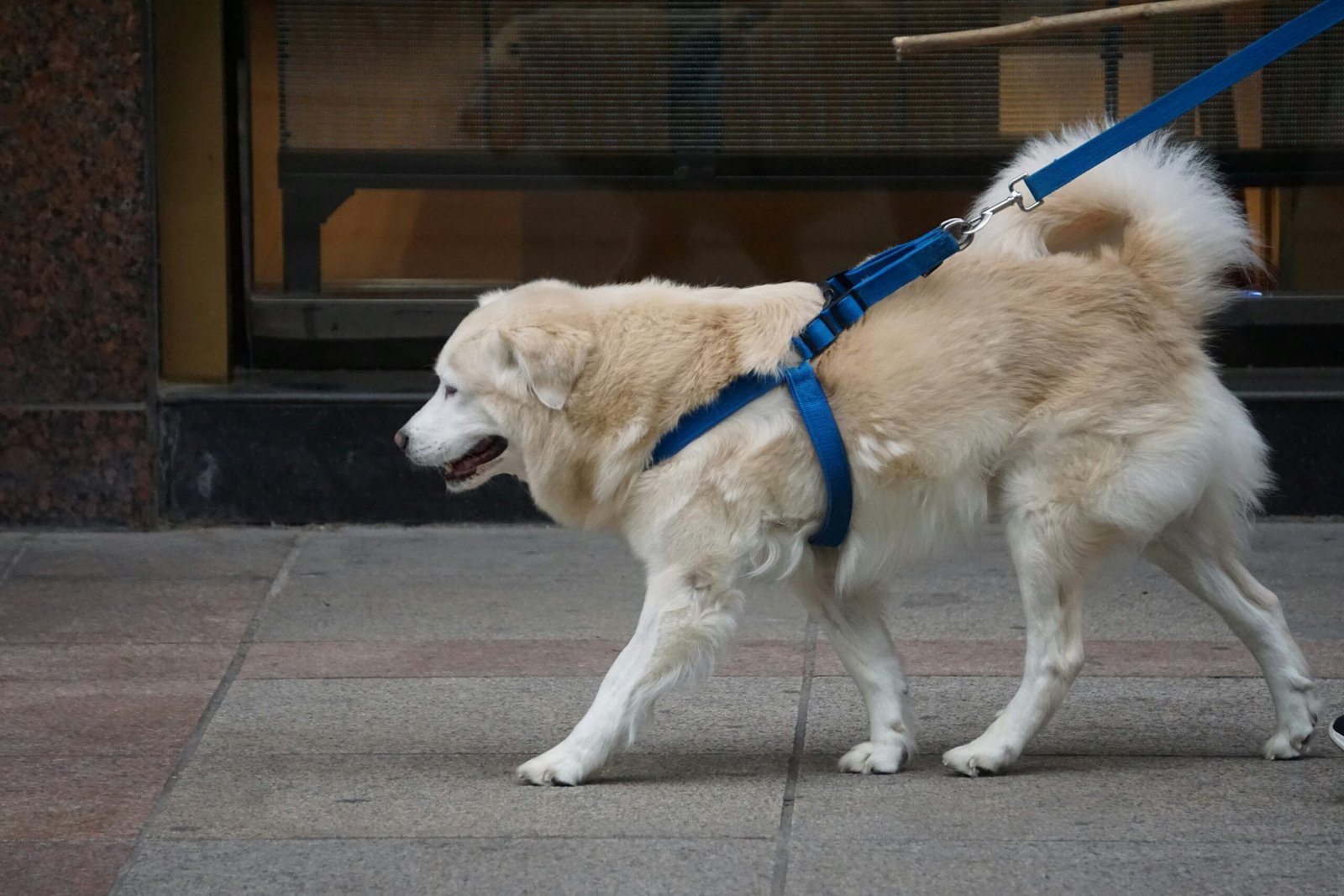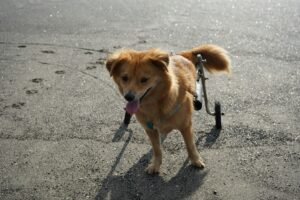Introduction
You’ve probably noticed it — your senior dog doesn’t jump up to greet you like before, or maybe they hesitate before climbing the stairs. Mobility issues in senior dogs are one of the most common signs of aging, and they can quietly creep up over time.
Just like humans, dogs feel the wear and tear of years spent running, playing, and chasing tennis balls. Their joints stiffen, their muscles weaken, and sometimes, old injuries start to show again. What once looked like simple “slowing down” can actually be a sign of something more serious — pain, inflammation, or joint disease.
But here’s the good news: most mobility problems can be managed, slowed down, or even improved with the right care. Understanding what causes them is the first step to helping your dog move comfortably again and enjoy their golden years pain-free.
This post may contain affiliate links. If you buy through these links, I may earn a small commission at no extra cost to you. As an Amazon Associate, I earn from qualifying purchases.
Table of Contents
Common Causes of Mobility Issues in Senior Dogs
Mobility problems in senior dogs don’t just appear overnight. They usually build up slowly, caused by years of movement, weight, and small injuries that add up over time. Knowing the root cause helps you find the best solution for your dog’s comfort and long-term health.
1. Arthritis
Arthritis is the most common reason older dogs struggle to move. Over time, the protective cartilage in the joints wears down, leading to stiffness, swelling, and pain. You may notice your dog limping in the morning or taking a few steps before fully stretching out their legs.
2. Hip Dysplasia
This condition mostly affects larger breeds like Labradors, Golden Retrievers, and German Shepherds. The hip joint doesn’t fit properly into the socket, which causes pain and limits range of motion. Even with good care, dysplasia can worsen with age.
3. Muscle Loss (Sarcopenia)
As dogs age, they naturally lose muscle mass — especially if they move less due to pain or stiffness. This muscle loss makes joints work harder and increases the risk of injury or imbalance.
4. Obesity
Extra weight puts unnecessary pressure on joints and bones. Many senior dogs slow down because they’re carrying more than their frame can handle. Weight management is one of the simplest — and most effective — ways to help improve mobility.
5. Old Injuries
A sprain or fracture from years ago can come back to cause pain later in life. Scar tissue and uneven movement patterns often make these areas weaker and more sensitive as dogs age.
6. Neurological Conditions
In some cases, mobility problems are caused by the nervous system rather than the joints. Diseases like degenerative myelopathy or spinal issues can affect how well the brain and muscles communicate, leading to wobbling or dragging of the paws.
Each of these issues affects your dog differently — but the earlier you recognize them, the more you can do to keep your senior dog mobile and comfortable.

Recognizing the Early Signs
Mobility issues in senior dogs usually start slowly. Many owners assume their dog is just “slowing down with age,” but these small changes often signal joint pain, stiffness, or discomfort that can be managed if caught early.
Here are some of the first signs to watch for:
- Stiffness or slow movement after waking up or resting.
- Hesitation to climb stairs, jump on the couch, or get into the car.
- Shorter walks or stopping more often than usual.
- Difficulty standing up after lying down.
- Slipping or losing balance on smooth floors.
- A drop in energy or enthusiasm during playtime.
If you notice any of these signs, it’s important to pay attention rather than write them off as normal aging. Early action — through gentle exercise, weight control, and proper joint support — can help keep your dog moving comfortably for years longer.
Real-Life Story: Arnhem’s Journey Back to Mobility

Arnhem, a 9-year-old German Shepherd, had always been full of energy. He loved running outdoors and joining his owner on long walks and adventures. But one morning, after chasing deer through the woods, his owner noticed something wasn’t right. Arnhem hesitated to move, his back legs seemed weak, and even standing up took effort.
After a vet visit, Arnhem was diagnosed with Degenerative Lumbosacral Stenosis (DLSS) — a condition that affects the spine and nerves in older dogs, especially large breeds. The diagnosis sounded worrying, but it wasn’t the end of Arnhem’s active life.
With the help of a physiotherapist, Arnhem began a tailored program that included hydrotherapy, muscle-strengthening exercises, and gentle stretches. Over the following weeks, his balance and strength slowly returned. The stiffness in his back legs eased, and his confidence grew with every session.
Today, Arnhem still enjoys hiking and spending time outdoors. He moves a bit slower, but he’s happy, pain-free, and full of life again — proof that with the right care and early attention, mobility issues in senior dogs can be managed and improved.
How to Support Mobility in Senior Dogs
While aging is inevitable, mobility issues in senior dogs don’t have to mean the end of an active, happy life. With the right care and a few lifestyle changes, you can help your dog stay strong, comfortable, and mobile for years longer.
1. Keep Your Dog Moving
Gentle, regular exercise helps maintain muscle strength and flexibility. Try short, consistent walks instead of long, intense ones. Swimming is also excellent for joint support because it builds muscle without putting stress on the body.
2. Maintain a Healthy Weight
Extra pounds put unnecessary pressure on aging joints. If your dog has slowed down, adjust meal portions or switch to a senior-specific formula designed for weight control. A leaner body means easier movement and less joint pain.
3. Provide Joint Support
Many senior dogs benefit from joint supplements containing glucosamine, chondroitin, and omega-3 fatty acids. These help reduce inflammation and improve joint lubrication, keeping movement smoother and less painful.
4. Invest in Comfortable Bedding
Hard floors can make joint pain worse. An orthopedic dog bed supports your dog’s body evenly, reduces pressure points, and helps them rest better — which is essential for recovery and comfort.
5. Schedule Regular Vet Visits
Routine checkups can catch mobility problems early. Your vet might recommend X-rays, blood tests, or specialized treatments such as laser therapy or hydrotherapy to maintain your dog’s strength and comfort.
6. Create a Senior-Friendly Home
Make daily life easier for your dog:
- Add rugs or mats to prevent slipping.
- Use ramps for cars and furniture.
- Keep food and water bowls at a comfortable height.
Small changes like these can make a big difference in your dog’s confidence and movement.

When to See a Veterinarian
Some stiffness or slowing down is normal as dogs age, but certain changes can point to a deeper problem. Knowing when to see a veterinarian is key to preventing long-term pain or irreversible joint damage.
You should schedule a vet visit if you notice any of the following:
- Your dog cries, whines, or growls when touched or lifted.
- They suddenly limp or refuse to put weight on one leg.
- There’s visible swelling or heat in their joints.
- They have trouble standing up or collapse after short activity.
- You notice dragging of the back legs or loss of coordination.
- Their appetite or mood changes along with mobility issues.
A veterinarian can perform X-rays, blood work, or mobility tests to identify what’s happening — whether it’s arthritis, nerve damage, or another underlying condition.
Early diagnosis not only makes treatment easier but can also slow down joint degeneration and give your senior dog a better quality of life.
Even if the signs seem minor, it’s always safer to have them checked. In most cases, early care and pain management can help your dog move comfortably for many more years.
FAQ: Mobility Issues in Senior Dogs
1. What causes mobility issues in older dogs?
Mobility problems often come from arthritis, hip dysplasia, muscle loss, obesity, past injuries, or neurological conditions. These issues make walking, running, and jumping harder for senior dogs.
2. Can senior dog mobility improve?
Yes. With gentle exercise, weight management, supplements, and proper care, many senior dogs regain strength, flexibility, and comfort — though they may move a little slower than when they were young.
3. What exercises are safe for senior dogs with joint pain?
Low-impact activities like short walks, swimming, and controlled stair climbing are ideal. Avoid high-impact exercises like long runs or rough play on hard surfaces.
4. Do joint supplements really help?
Supplements containing glucosamine, chondroitin, and omega-3 fatty acids can reduce inflammation, improve joint lubrication, and support cartilage health. Always consult your vet before adding new supplements.
5. How can I tell if my dog’s pain is from arthritis or another issue?
Watch for limping, stiffness, reluctance to move, and changes in behavior. Your vet can perform tests like X-rays or blood work to determine the cause and recommend treatment.
6. Are there home adjustments that help senior dogs move better?
Yes. Add non-slip mats, ramps for cars and furniture, orthopedic beds, and accessible food and water bowls. These small changes make daily life safer and more comfortable.
Final Thoughts
Mobility issues in senior dogs are common, but they don’t have to mean a loss of quality of life. Understanding the causes — from arthritis and hip dysplasia to muscle loss and past injuries — is the first step in helping your dog stay active and comfortable.
Early recognition, gentle exercise, proper weight management, joint support, and a senior-friendly home can all make a significant difference. Regular vet checkups ensure that any underlying conditions are caught and treated promptly.
With the right care, many senior dogs can continue to enjoy walks, playtime, and cozy naps without pain. Paying attention to your dog’s changing needs today can help them live a happier, healthier, and more mobile life in their golden years.
Sources
https://www.awelladjustedpet.com/arthritissenior-mobility-issues.html
https://faithfulfriendsvetclinic.com/managing-arthritis-in-senior-dogs-tips-for-comfort-and-mobility/
https://www.petmd.com/dog/conditions/neurological/neurological-disorders-dogs
https://mycanineaquaticcenter.com/hydrotherapy-for-aging-dogs-maintaining-mobility-and-comfort/
https://www.woofdoctor.vet/senior-dog-mobility/
https://www.dipndogs.com/blog/hydrotherapy-for-osteoarthritis-djd-in-dogs
https://www.rovervetcare.com/jupiter/blog/2025/common-mobility-issues-in-aging-pets.html
https://winstonandporter.com/blogs/news/hydrotherapy-for-dogs-and-how-it-can-help-dog-arthritis-symptoms
https://zestypaws.sg/blogs/news/senior-dog-mobility-tips
https://www.smalldoorvet.com/learning-center/seniors/mobility-deafness-blindness-dementia-senior-dogs
https://www.petmd.com/dog/care/hydrotherapy-dogs
https://www.simonvetsurgical.com/news/the-role-of-water-therapy-in-treatment-for-canine-arthritis




Pingback: How to Help Senior Dogs with Arthritis at Home (2025 Guide)